Brooklyn, New York (1864 – c. 1912)
Old Bridge, New Jersey (c. 1906-1921)
Bushwick Glass Works began as a bottle manufacturing operation in 1864. The factory site was located near the intersection of Grand Street and Morgan Avenue in the Bushwick area of Brooklyn, New York.
James Madison Brookfield (1813-1892), who had moved to Brooklyn some time after the Honesdale Glass Works of Tracyville, Pennsylvania (which he had owned) was destroyed by a flash flood in 1861, seems to have been the main person involved with the management of this establishment in the earlier years, probably from its very beginning.
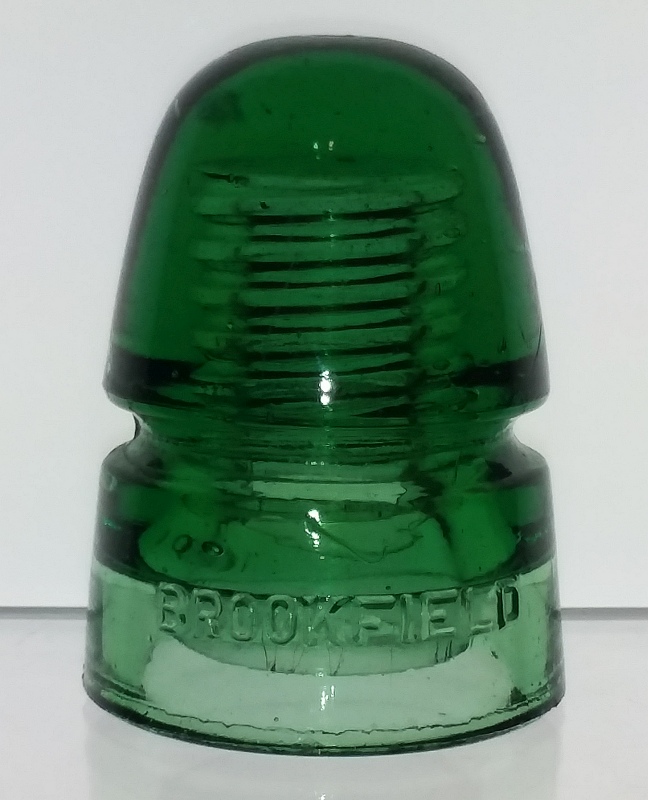
Businessman Martin Kalbfleisch, owner/proprietor of the Bushwick Chemical Works, (Kalbfleisch also served as mayor of Brooklyn for a time in the 1860s), built the glass factory in 1864 in order to supply carboys and demijohns (large acid bottles) required for his business, and hired Mr. Brookfield to manage the operation. The factory was quite close (apparently, right across the street) to the main Bushwick Chemical Works buildings.
James M. Brookfield purchased the Bushwick glassworks from Kalbfleisch in approximately 1869. In later years his son (William Brookfield), and later, grandsons, eventually would become involved with the operation of the company.
ADVERTISEMENT
Many types of bottles and jars were made, especially in the earlier years, and judging from the content of advertisements as late as the 1890s, were continued to be made throughout most, if not all, of the duration of the company’s operation, although not a lot is known about them. Most were evidently unmarked, and/or were made for companies with only the product or company name embossed on them. Brookfield made many (if not all) of the “RRR / Radway’s Ready Relief” patent medicine bottles, as mentioned in a trade magazine article (Crockery and Glass Journal, Sept 9, 1875). That article is reproduced here, courtesy of Bob Stahr and Bob Berry, at the Insulator Gazette database website: https://reference.insulators.info/publications/view/?id=411&h0=kalbfleisch.
Large quantities of square pickle bottles, chow-chow (tomato/vegetable pickle relish) jars, and many containers for “Vinegar Bitters” were made, as mentioned in that article. The “Vinegar Bitters” are almost certainly the “Dr. J. Walker’s Vinegar Bitters” bottles which are found frequently in light aqua as well as (much less commonly) in various shades of green similar to the colors of Brookfield-made insulators of the same period.
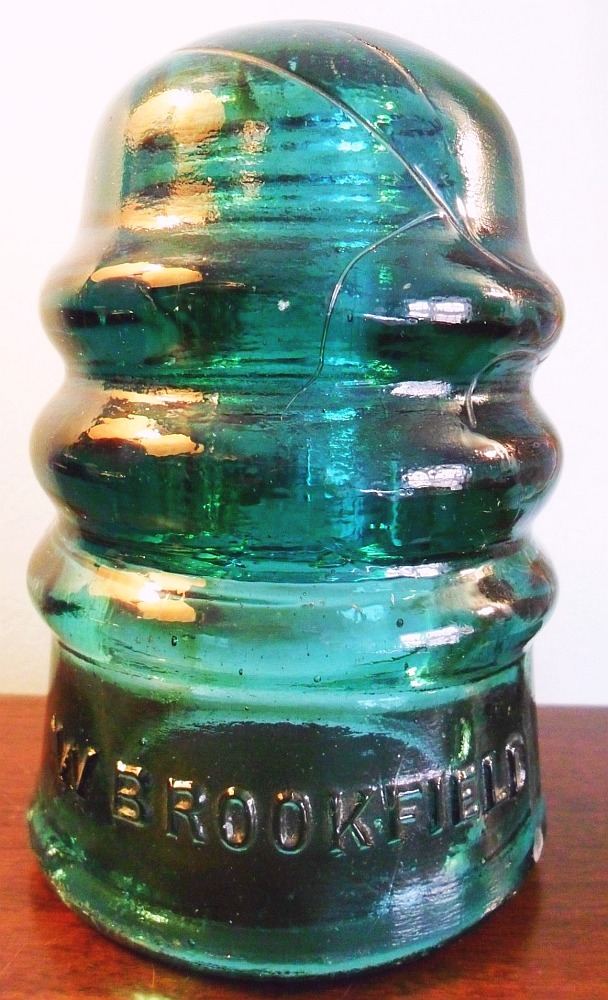
The mold room is described as being crowded with many, many bottle molds, so there are, no doubt, many types of patent medicine and other product bottles that were made here in large quantities, yet remain unidentified to the present-day bottle collector.
A cylinder whiskey bottle is known to exist which is embossed “BUSHWICK GLASS WORKS” in a circle on the base. This bottle is mentioned in McKearin & Wilson’s American Bottles and Flasks and their Ancestry (1978), page 221. Evidently it is a very rarely seen item, and probably dates from the 1860s- 1880s. A mere handful have showed up over the last few years in ebay auctions. Also, a very rare type of fruit jar embossed “Brookfield/55/Fulton St/N.Y.” is known, but only a very few examples have been found by collectors.
In recent years it has become apparent that the mark “B G W” was also used by Bushwick Glass Works, but only on a mere handful of handblown soda and beer bottles. For instance, one blob-top soda bottle is marked “M / MINCK BROS & CO / 45 to 53 BEAVER ST / BROOKLYN E D” on the front and “M / M B & Co [monogram]” on the reverse. The base is marked “B G W / 4”. (Thanks to Brookfield researcher Lee Brewer for that info).
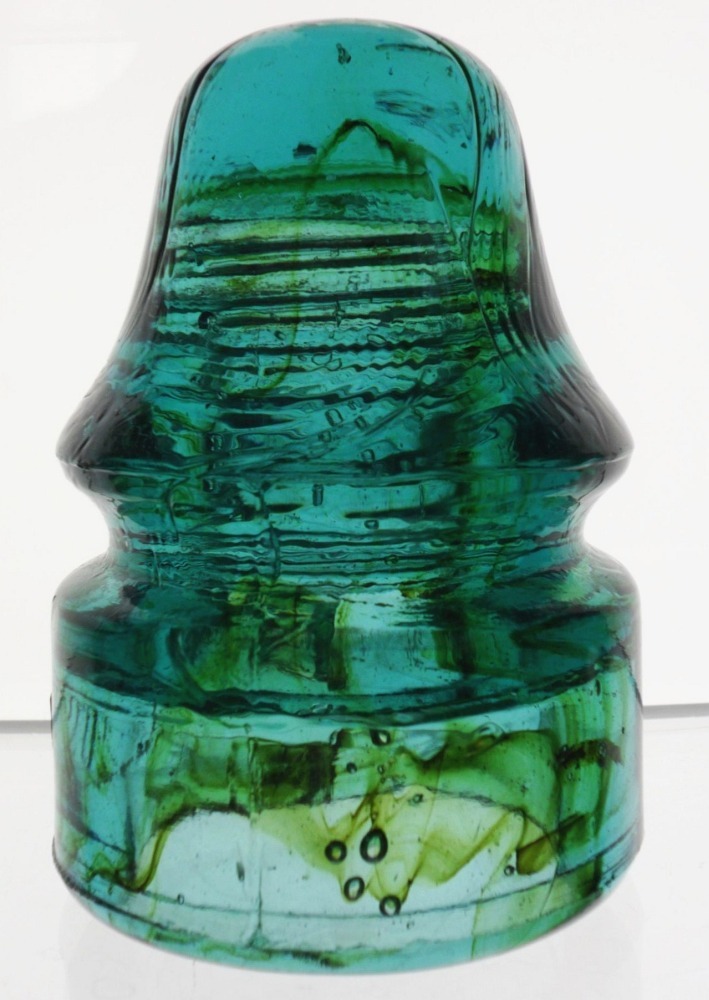
The production of electrical insulators rapidly increased in the late 1860s and ’70s, until by the 1880s a large percentage of their glass production consisted of insulators for telegraph and telephone lines. The 1890s saw increasing production of insulators for (higher voltage) electrical power lines.
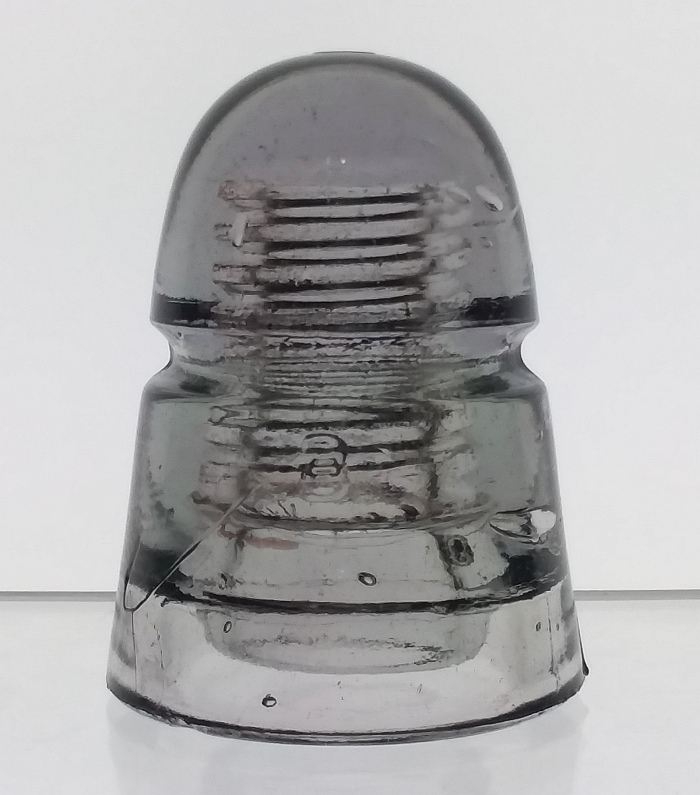
The great majority of the insulators from the Brooklyn plant are found in a pale blue-aqua color. Insulators in shades of “true” green from this earlier period are considerably less common. Judging from the huge numbers still in existence, Brookfield was second only to the Hemingray Glass Company in the sheer number of insulators they manufactured.
In all likelihood, the majority of glass insulators installed on open wire communication lines in the Eastern part of the United States during the 1880s-1910s were products of the Brookfield glass factory.

For a period of approximately 57 years, huge quantities of insulators marked “W.BROOKFIELD”, “BROOKFIELD”, and “B”, were produced. It’s very likely some of the earliest insulator styles that were made (circa 1864-1868) were not marked with a manufacturer’s name, and so remain currently unidentified as Bushwick products.
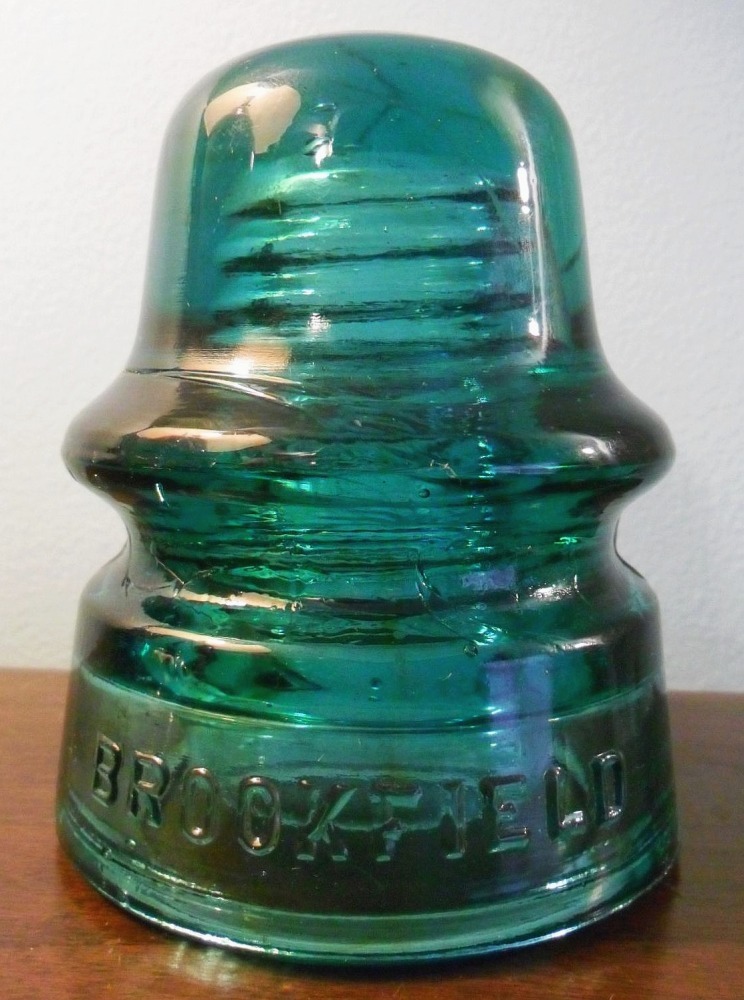

Brookfield made insulators for various utility companies, (telephone companies, railroads, electric power companies) and some of these are found with embossed initials / names on them, such as A. T. & T. Co., G.E. Co., C. D. & P. Tel. Co., etc.
Brookfield maintained business offices in Manhattan throughout most if its history, and those office addresses were embossed on many of the earlier insulators. 55 FULTON ST (1868-1882); 45 CLIFF ST (1882-1889) and 83 FULTON ST (1889-1893) are embossings found that may help date a particular example. However, it’s probable some molds were continued to be used for a length of time after the office changed locations. (Although an insulator collector might understandably assume so, just because of the markings, no insulators were actually made at those Manhattan locations. They were made at the factory site in Brooklyn).
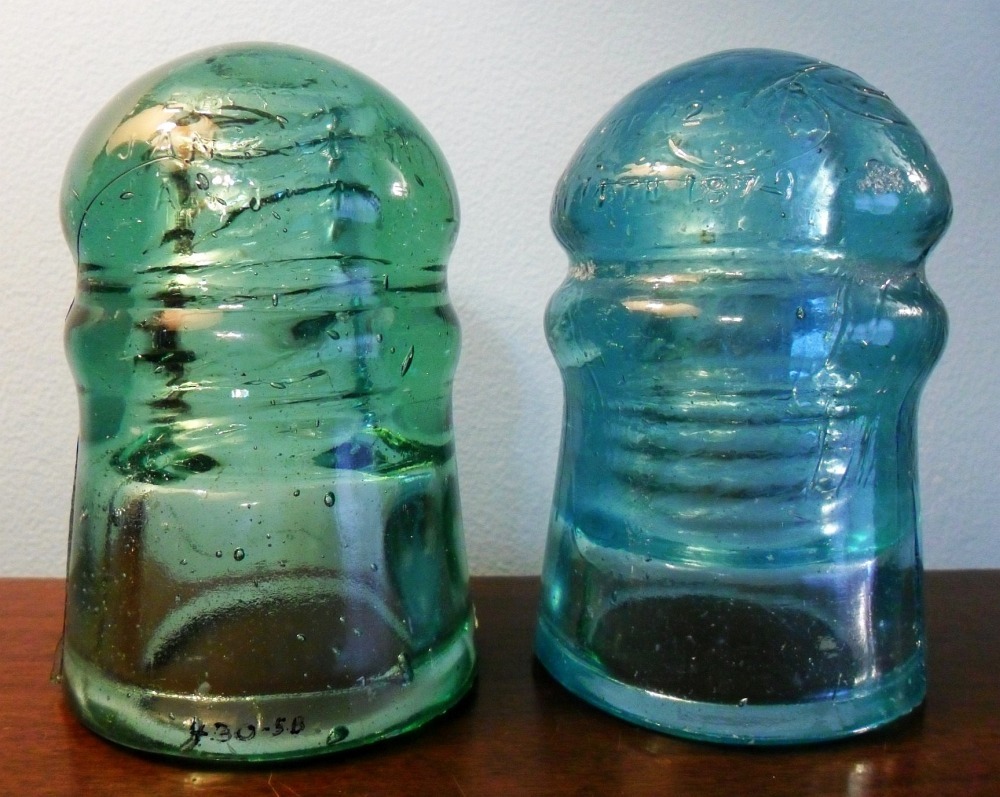
Brookfield made more than 100 different types of insulators during its history, and some types that are illustrated in their 1912 catalog have never been found (assuming they actually existed).
ADVERTISEMENT
A second glass plant was built in Old Bridge, New Jersey, and from recently discovered evidence by collector/historian Bob Stahr, that plant seems to have commenced glass production in about 1906. The exact time when the Brooklyn plant was closed is still open to question, but it may have been around 1912, meaning that both plants likely operated simultaneously for a period of around 6 years. However, production of insulators may have ceased at Brooklyn soon after the Old Bridge NJ plant was in full operation, leaving the Brooklyn location to concentrate exclusively on bottle production, especially beer bottles.
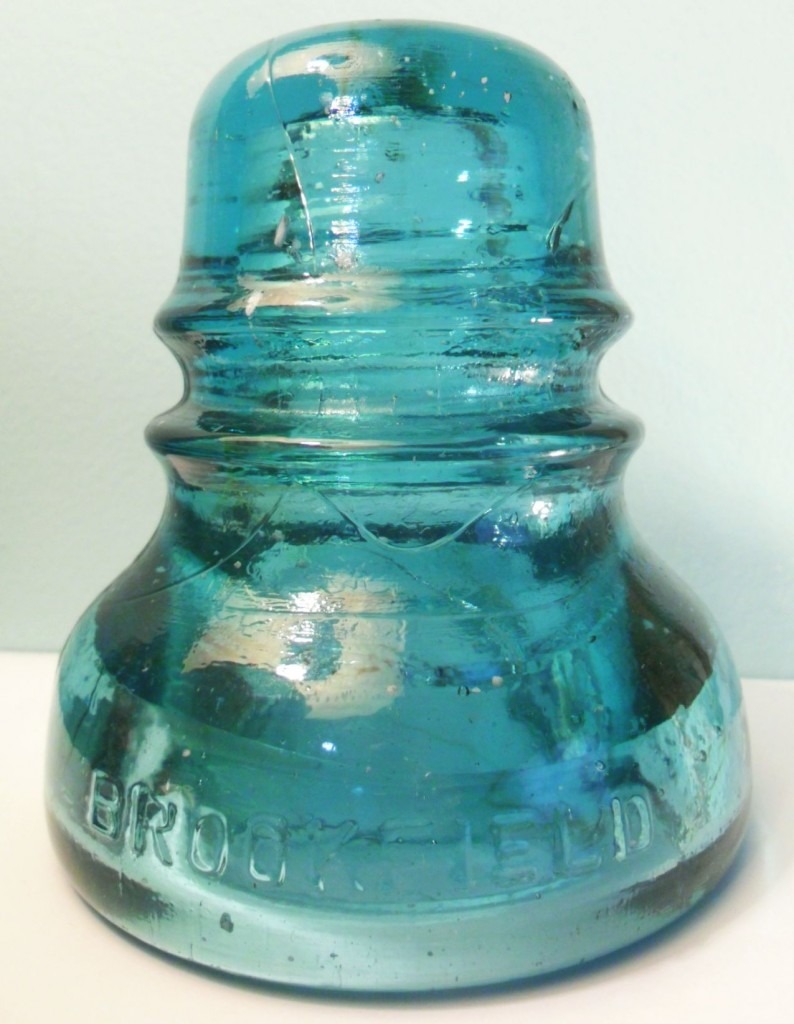
The Brookfield Glass Company was officially incorporated in 1898 and (again!) in 1908, although that exact company name may have been used, unofficially, for a considerable time beforehand. One interesting note: No insulators are known with a “Bushwick Glass Works” marking.
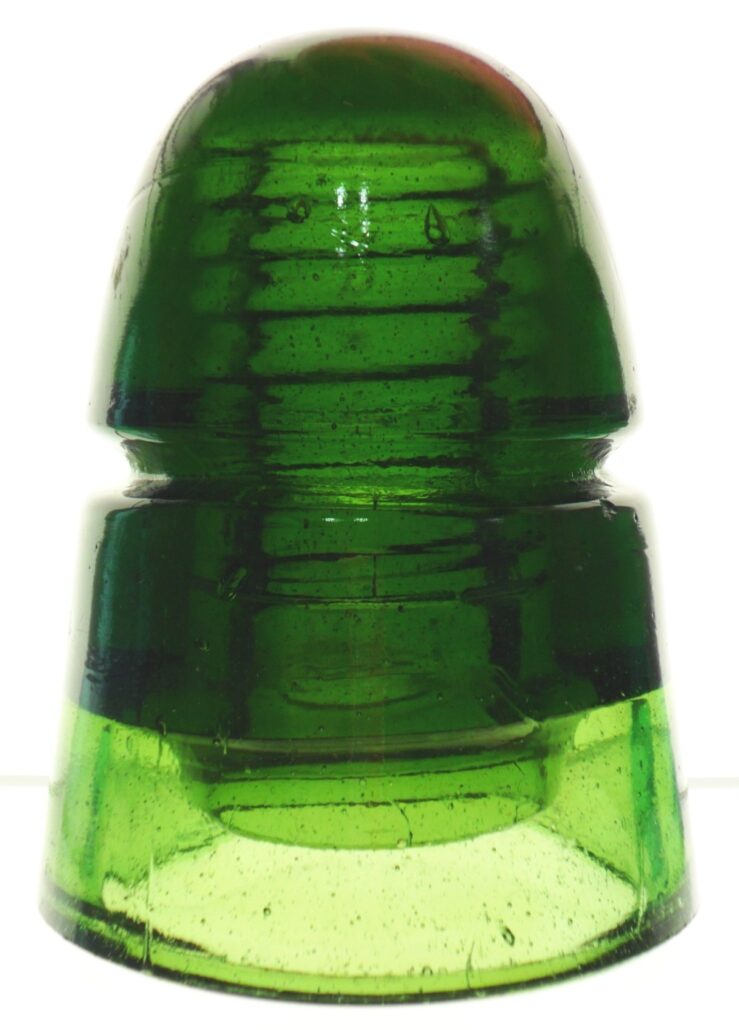
Much of the later production at the New Jersey location tends toward the darker shades of aqua, “teal”, shades of dark green including emerald and olive greens, and also dark olive ambers, and dark amber striped insulators.
The Old Bridge glass plant apparently shut down for good on January 8, 1921, according to information published in the January 11, 1921 issue of the Perth Amboy Evening News (thank you to collector and researcher Lee Brewer for uncovering this obscure bit of information!) NOTE that it is somewhat unclear if insulator production had continued all the way up to that date. The corporation itself was officially dissolved in September of 1922.
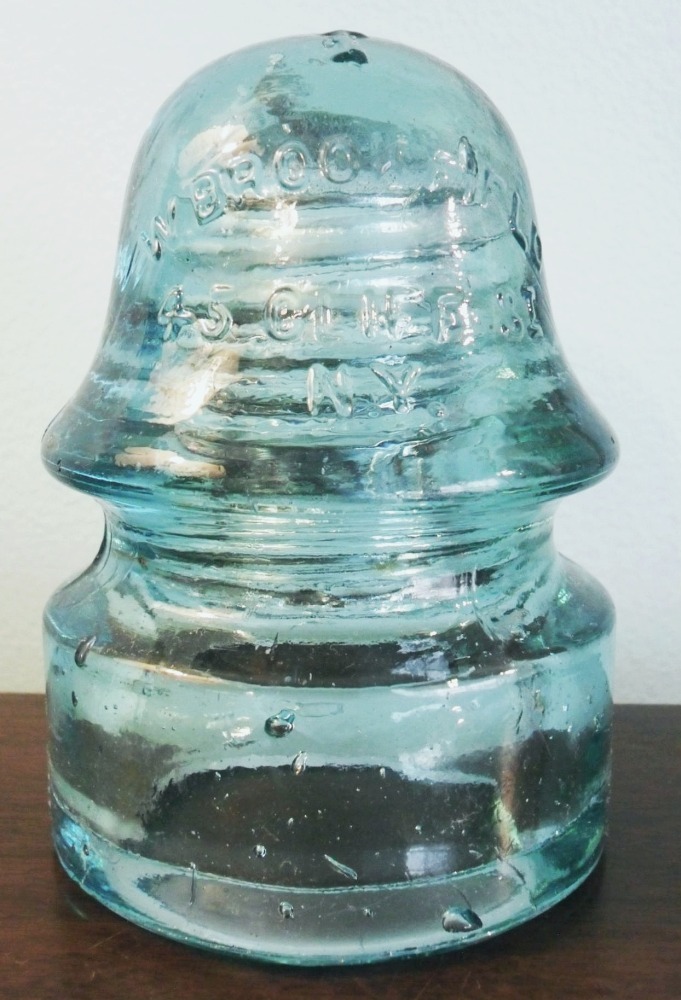
Note: In general, the name Bushwick Glass Works applied to the physical factory, and Brookfield Glass Company was the actual firm (company or business organization) that operated the works, although these two names are often used interchangeably and may be considered almost synonymous. However, Bushwick Glass Works can properly only be applied to the first glass factory operation in Brooklyn, not the later glassworks in Old Bridge.
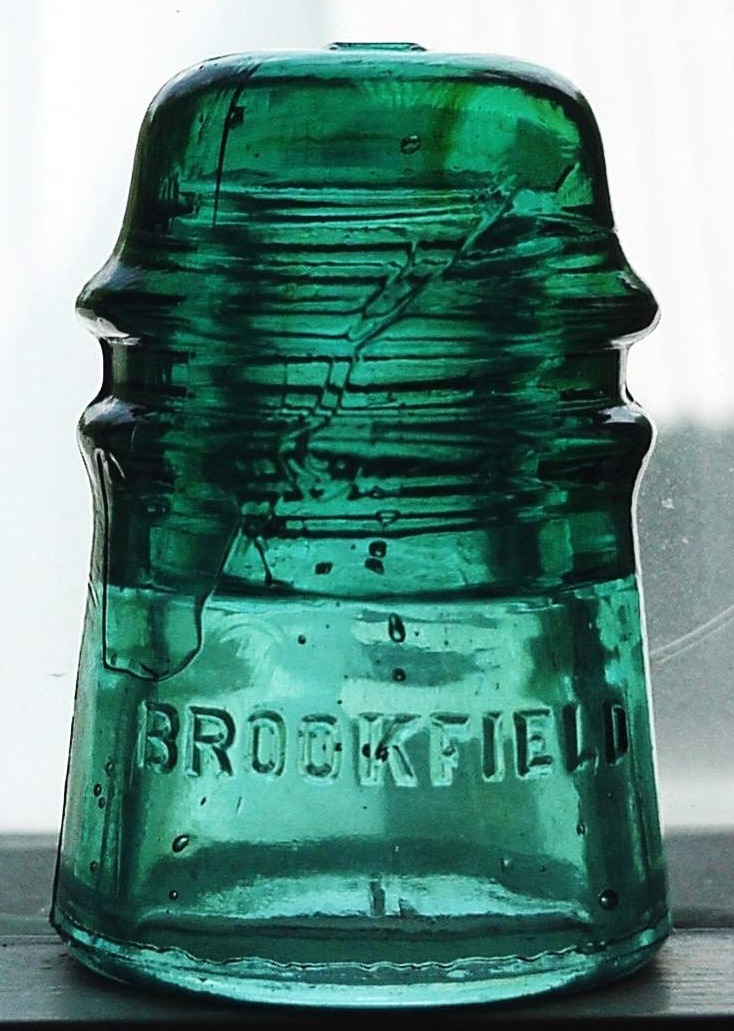
NOTE: I also wanted to make it clear in this article that the commonly seen “baby face” milk bottles marked “BROOKFIELD” (that show up frequently at antique malls and flea markets) have NO CONNECTION whatsoever with the Brookfield Glass Company. Those milk bottles were made many years after Brookfield Glass Company had closed its doors, and in any case the “Brookfield” embossing is referring to a dairy, not a glass company. For more info on the BROOKFIELD milk bottles, most of which are modern reproduction bottles, see my article here: Brookfield Baby Face Milk Bottles.
Sources for some of the information in this article include: N. R. “Woody” Woodward (The Glass Insulator in America: 1988 Report), Elton Gish, Bob Stahr, Lee Brewer, Glenn Drummond, Alice Creswick and Helen McKearin.
(Pictured at the top of this page: Group of three “pony” style telephone insulators. From left to right: CD 102 embossed “BROOKFIELD//NEW YORK”; CD 112 embossed with just a “B”; CD 103 embossed “B”).
For a basic list of glass factories in the United States that are believed to have made glass insulators at some time in their history, please go to my “Glass Insulator Manufacturers” page here.
Please click here to go directly to the GLASS MANUFACTURERS’ MARKS pages (Page One).
NOTE: New book detailing early-period Brookfield-made “beehive” style insulators: “A Comprehensive Guide to Collecting and Identifying Crown Embossed Brookfield Beehive Insulators, including an Extensive Study of Brookfield Glass Company History” written by Lee Brewer, 269 pages.
I wanted to give a “plug” for this book which was privately published and released to the public in 2015. Lee Brewer, a longtime collector and researcher of Brookfield insulators, has worked on this book for well over a decade and his commitment to detail and accuracy is apparent on every page. He concentrates on the earlier “CREB” (Crown Embossed Brookfield) beehive variants with shop numbers on the dome, which are believed to date from the circa 1882-1897 time period. All were made at Brookfield’s first factory location at Brooklyn, New York.
Included in this book are clear closeup photos of every known/confirmed shop number variant. Lee’s meticulous research details the minor differences of the many different molds used over this time frame. Those shop numbers range from 00 to 23, and the shop letters A and B.
Also included are newspaper and glass journal article summaries; factory diagrams; personal letters from William Brookfield to his mold maker; a letter from a former Bushwick plant employee; a letter from James Brookfield (grandson) about factory details, and other lists and appendices as well as an extensive index.
The book also includes a very handy and highly readable “Frequently Asked Questions” section on Brookfield as well as glass insulator production in general. Price (postpaid) is $50.00 shipped anywhere in the United States. (Canadian addresses, please write Lee and ask for shipping quote).
For more information you may contact Lee via regular (USPS) mail, or email:
Lee Brewer
344 S Main
Bellefontaine, OH 43311
lbrewer_42@comcast.net
ADVERTISEMENT

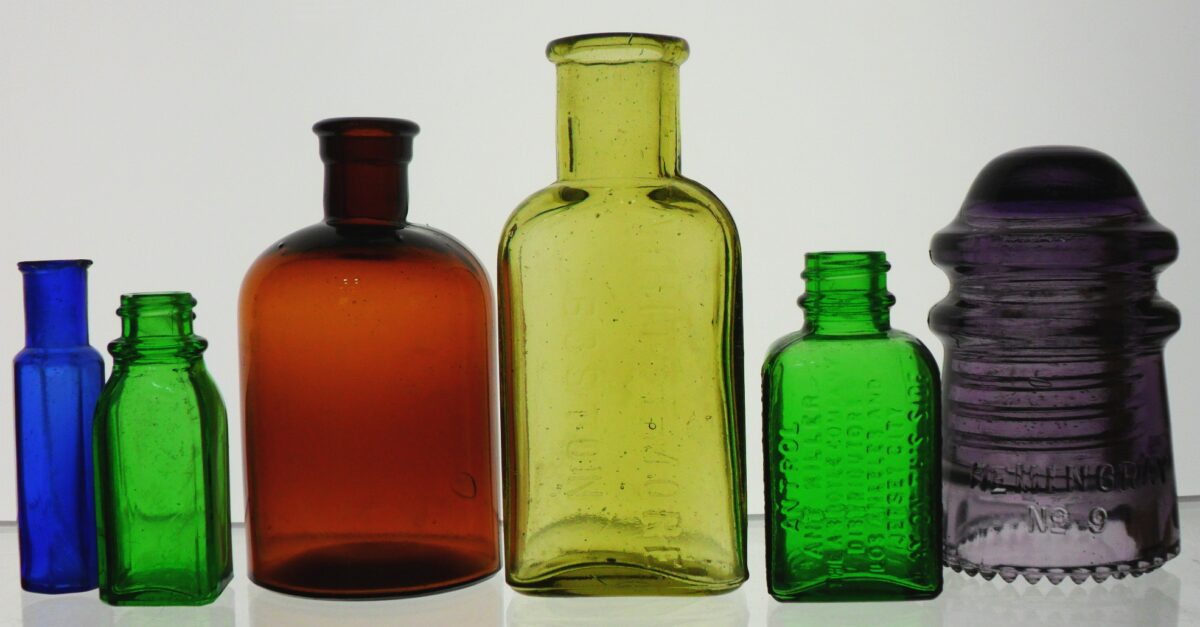
I just picked up a Brookfield insulator yesterday. I cannot find a picture of it on any site. Just like to know a little about it.
Ron, I sent you an email Thursday, April 20. Please check your email inbox, and if not there, maybe your trash/spam folders. If you can email me pics of the insulator I will try to identify it for you with more info.
Thanks, David
I have a Brookfield 00 , bee hive style insulator . I was wondering if it a common glass insulator?
Hi Thomas,
Yes, the shop number “00” seen on the dome of many beehives made by Brookfield, is rather common. Most of those are the “Western Union style” beehive with the letter “B” located on one side right underneath the wire groove. Many of them are seen in shades of very dark aqua or “teal aqua” as well as dark green. I’ve thought that number was rather an odd one to use, but I don’t know why they used a double number instead of just a single “0”. They probably had some perfectly logical reason at the time, but we don’t know what it is today. Sometimes the two zeros are so close together as to nearly look like a number 8! Hope this helps,
~David
Hi David. I was reading Thomas’s message and your reply. Mine is green in color with the B stamped on one side. On the top it has a 5 which is backwards when looking down on it. If you look through the threaded opening the 5 is perfect. Any chance you know what the 5 stands for? And did they always stamp it that way. It’s a raised number 5 /embossed but I don’t see how or why it’s backwards. Thanks
Hi Jeffrey,
The “backwards 5” you see is what’s called a “shop number”. Many numbers (often backwards) are found on the top of Brookfield glass insulators and these are believed to be what are called “Shop numbers”. There were a number of “shops” working simultaneously at the factory. Each shop (a team or group of glassworkers, usually consisting of 3, 4 or 5 workers) at the factory was assigned a certain number, and that number was embossed on insulators, so that when they were counted (or weighed) and packed after removal from the cool end of the lehr (cooling oven), the number was carefully noted so the proper amount of wages could be paid to each shop.
This information was first explained/published by early “pioneer” author, researcher and collector N.R. Woodward in his books about insulator collecting that were first published in the mid-1960s. Although I think no one has proven beyond a shadow of a doubt that this is the correct explanation, I believe it is almost certainly right. Mr. Woodward had interviewed and communicated with many people involved in the earlier insulator manufacturing industry throughout the years he was gathering information for his books.
The shop numbers often appear backwards on the insulators, which merely meant that they were engraved “correctly” into the inside of the insulator mold. Personally, I think that Brookfield company officials did not really care that much whether the number was embossed correctly or not as long as it was clear which number was intended. Often, I think the mold engraver was under a lot of pressure, and in a hurry and didn’t take the trouble to engrave the number backward into the mold, which would be necessary in order for the number to appear correctly on the finished insulator!
Here is a webpage that mentions shop numbers, although this page is mainly referring to the older types of “CREB” Brookfield beehives: https://www.insulators.info/articles/cd_145_creb.htm
Hope this helps a little!
David
I have a W Brookfield beehive insulator with 2 embossed “nipples / dots” on top and it also has “New York” on it . There are no numbers or other letters on it. Just wondering about it.
Thank you Renita
Hello Renita,
Some Brookfield insulators (of several styles, including small “ponies” and “beehives”) are found with one or two “raised dots” on the very top. No one is sure what they are for, but it is generally assumed they were intended as a mold identifying mark, probably equivalent to a number or letter. Some collectors believe the molds used for these particular insulators were acquired by Brookfield from B.G.M.CO. (Baltimore Glass Manufufacturing Company, c.1895-1897) after Brookfield won a lawsuit against that company, and the molds were subsequently re-tooled with Brookfield markings.
David
I recently found a Brookfield CD 152 (SDP) insulator on a pole in Ohio with an embossing error, and I’m wondering if anyone can tell me if it is rare or valuable or not since I cannot find any information on the internet.
It is embossed “BBOOKFIELD” and that second letter is very clearly another “B” even though the embossing is not strong. Also I must note that there is a chip (a square 1/4 inches) on the bottom edge just above the drip points.
I am a new collector so I don’t know too much, any input would be appreciated!
Hello Ethan,
Your insulator is not common, but not that rare either. It is listed as index [030] under the CD 152 “BROOKFIELD” listings in the price guide. I don’t have the very latest edition, but the value as shown in my book reads “10 to 15” dollars in aqua. Of course, with the damage the value of your example would be somewhat less. Any color other than aqua, such as true green or olive amber, will be worth more. BTW, there is also a SB (smooth base) version with that embossing error! It is listed as embossing index [020].
I would recommend that anyone seriously interested in collecting antique glass insulators should try and find a copy of the glass insulator price guide, originally edited by John & Carol McDougald, and more recently, by Don Briel. There have been several editions since 1991. I have no direct connection with either of those authors and have no financial reason to promote them, but in all honesty I must say that they are INVALUABLE for the wealth of information crammed into the pages of those price guides!
Getting the very latest edition would be best, but even finding an older copy would be good, since much of the same basic info is there, notwithstanding some of the stated values (which is what I would characterize as ‘estimated market value ranges’) have changed — having went up (or down, in some cases).
Hope this helps,
David
I have a blue-green Brookfield with XI on the top. Any idea what that means ?
Lisa, that is a shop number (or shop identification mark). Usually a number, sometimes a letter or number/letter combination. Shop numbers identified a particular “shop” (group of glass workers) at the factory. Often many shops were producing insulators (or bottles, or whatever) simultaneously. Counting the insulators after they came out of the lehr (cooling oven), and recording how many insulators were made from each shop, the workers were paid for their output. There are many different shop numbers seen on Brookfield and Hemingray insulators. Brookfield used shop numbers OO through 23, and others such as XO (or OX), A and B.
Hope this helps,
David
Mine has a B on it. With just an X on top and imperfections in the glass not chips
Hi Lacey, I am guessing you have a “beehive” style insulator? They are the most common Brookfield insulators with a “B” on the skirt, right underneath the wire groove. Sometimes the B is rather faint and can be easily missed if someone doesn’t look closely.
Take care,
David
Hello, I am curious is there any known color reference guide for Brookfield glass insulators ? After reading how these things were made, I’m guessing that no such thing exists? I’ve come across so many different shades of the same insulator, unlike Hemingray’s which seem have a disctint color guide. Thank you, George
Hi George,
I’m not sure I understand your question. Are you asking if there is a book or website available with color photographs illustrating the various shades of color that can potentially be found in Brookfield insulators? If so, the strict answer is no, although you can “piece the information together” by cruising a number of different sites where a good variety of Brookfield insulators are shown, such as the “Picture Poster Pages” on the site http://www.insulators.info . In that area of the site, many people have posted tons of photos of insulators for many years, including lots of insulators that were posted for sale, or just for informational purposes, and usually a color term is included in the description given by the poster of the photo.
Also, the hardcopy price guide used by most insulator collectors (formerly compiled and published by John and Carol McDougald, now by Don Briel) includes listings for more than 14,000 different insulators including many hundreds, if not thousands, of Brookfield insulators.
These listings include color terms such as “Green”, “Dark Green”, “Yellow Green”, “Emerald Green”, “Green Aqua”, “Olive Green”, “Light Aqua”, “Light Green Aqua”, “Aqua”, “Dark Aqua”, “Olive Amber”, “Emerald Green”, “Purple”, “Light Sapphire Blue”, etc, etc.
I should mention that it is VERY common for insulator collectors to discuss color variants endlessly, and frequently disagree with others on exactly what shade a particular color term actually represents. Sometimes a particular color is given more than one name by different collectors. And besides that, colors may actually appear slightly different to different people. Some who are colorblind may see a color differently than someone who is not. Colors as seen in photos online and in books or magazine photos may not appear exactly as they do in real life.
I would suggest you take some of your insulators to an insulator and/or antique bottle show (if one happens to be put on in your area of the country) and ask a number of dealers and collectors there to “name the color”….. just to see what kind of answers you will get!! It would be an interesting experiment.
May I ask what “Distinct color guide” for Hemingrays you are referring to? Some styles of older Hemingrays are found in a very wide range of shades of color (such as the “H.G.CO. / PETTICOAT” beehives) but, then again, many of Hemingray’s later, most common styles were made in a typical medium aqua color which I would call “Muncie Aqua”. A typical example is the Hemingray NO. 40. Most of the “40s” seen are in that shade of color.
Hope this information helps a little!
Take care, David
David, Thanks so much for helping me. I found a color guide for Hemingray insulators on Hemingray.info. I don’t know if this came from Hemingray or just someones interpretation for reference. It seems pretty accurate though that I can match up just about any of my Hemingray’s to one of the color’s listed there. Where as Brookfield’s for ex. Signal CD 162 insulators and especially the CD 152, when it comes to the color green it could be in a dozen different shades of green etc. Thanks again for putting the time into my question. Sincerely, George
Hi George,
The Hemingray.info site is published by Hemingray collector, historian and researcher Christian Willis, and I assume he is the person who put together the Color guide to Hemingray insulators on his webpage: https://www.hemingray.info/database/colors.php
Christian is showing the colors more likely to be seen in Hemingray insulators, but there are other MINOR shades of color that are hard to define which are not shown. In my opinion there are actually as many different shades of green known in Hemingray insulators (taking all known Hemingray insulators as a whole, across their entire time frame of the 1850s to 1967), or even more, as there are in Brookfields, but some of those shades are much harder to find in Hemingrays.
No, the Hemingray company itself never published such a guide. Besides, it has been over 50 years since the last insulator was produced at the Hemingray factory in Muncie (1967). During the time when most Hemingray insulators were being made, color was of very minor importance, except in the case of some insulators such as certain CD 162 signal styles made purposely in blues or ambers, and a few other styles.
Take care,
David
I ran across a CD 102 embossed Brookfield and New York on the skirt. However, it has a “7” embossed backwards on the top. If you look from the bottom thru the hole, the “7” appears correct. I noticed one shown in the pic to this article has a “4” embossed, but that “4” is not backwards. Do you know anything about this unusual “7”.
Hello George,
There are many Brookfield insulators, of a number of different styles, that bear “shop numbers” on the dome or crown of the insulator, and these numbers can be oriented either “normal” or backwards. In fact, on some styles of insulators the backward numbers are almost as common, if not equally as common, as their regular counterparts. Many are frequently seen on the “B” beehives. On one of their older insulator styles, the CD 126 “blobtop” (which was very popular during the 1880s and 1890s), I have personally seen the shop number “4” oriented normally, backwards, upside down, and sideways, on various mold varieties!! Evidently, whether or not the numbers appear correctly or backwards was not considered of any great importance at the factory……. just as long as the numbers could be easily seen and recognized by the workers on the “cold end” of the lehr. Of course, the reason why the number appears backward on the insulator is because it was engraved “correctly” on the inside of the insulator mold. To appear “normal” on the finished insulator, the number had to be engraved backwards in the mold.
Hope this helps!
David
Does anyone have any information about a cobalt blue Brookfield New York insulator.
Sandy, there are no authentic Brookfield insulators known in a TRUE cobalt blue color. Either your insulator is stained (a blue color stain or coating of some sort has been applied to the surface of the glass), or it has been irradiated to a shade of cornflower blue, OR you are misidentifying the real color (or using the wrong color term) of the insulator. Most Brookfields are found in some shade of aqua (blue-green) or shades of green. A few are known in light shades of amethyst. TRUE cobalt blue is a dark, rich intense shade of true blue such as found in the old VICKS VAPORUB salve jars and Milk of Magnesia bottles. Examples of the cobalt blue color as seen in modern or present-day glass bottles would be the SKYY vodka bottles and the BAWLS Guarana beverage bottles. If the insulator is NOT in that shade of color, it would probably not be classified as a true COBALT. Best regards,
David
Hey, I recently found a Brookfield insulator and have a question on the markings. One side reads W. BROOKFIELD
45 CLIFF ST
NY
And the reverse reads, with 3 patent dates
CAUVET
PAT
JULY 25, 1865
JAN 25, 1870
FEB 22, 1870
After my research it seemed odd that there were 3 patent dates, but what really interested me was the CAUVET name included in the markings. Seems uncommon, any feedback will be appreciated.
Troy
Hi Troy,
Without seeing a picture, I would guess your insulator is one of the types classed as a CD 133 (“signal”), CD 145 (“beehive style”) or CD 126 (“blob top”). Those CD numbers are part of the “Consolidated Design” cataloging system used by insulator collectors. You can use those keywords and search Google Images for pics of similar insulators to identify which style you have.
Brookfield was very fond of covering their insulators with lots of embossed markings, including several patent dates, in the 1870s, ’80s and 1890s. Many of them bear those three patent date markings. It might be considered as a form of marketing hype or “brand name bragging rights”. The 1865 date refers to the celebrated Cauvet patent, which basically introduced the idea of screw threading in pintype insulators. Prior to 1865, glass insulators’ pinholes were smooth (not threaded) and the insulators were simply placed over the peg, perhaps with some type of adhesive. Starting around 1865 insulators were made with a threaded pinhole (although in reality this was gradually phased in over a period of several years, even some threadless being made as late as the early 1870s). I think the Cauvet patent was still being embossed on SOME Brookfield insulators even several years after the patent had expired.
You might try searching through some of these photos posted on the insulators.info photo gallery. I’ve done a keyword search for pics that include the word CAUVET and you can see some insulator pics at the link here:
http://www.insulators.info/pictures/search/?query=cauvet&submit=Search
Hope this helps,
David
David,
Thank you for the feedback, the shape is very similar to the CD 126.3 and is light aqua colored. I found a piece of history on Brookfield glass and was able to narrow down the date using the street address, just couldn’t find info on CAUVET embossing, only that the patent was purchased by Brookfield.
Troy
Has anyone ever seen a CD 102 with “Brookfield” embossed on the lower lip of the wire groove? It’s light, but distinctly visible. It has the Brookfield and New York embossing on the skirt, but also some very faint lettering just above the standard lettering. Looks like one of the faint words is “New’ so it was probably part of an older New York embossing the was crossed out. All of which suggests a mold that was reworked. But I still can’t figure out how the Brookfield ended up in the wire groove!
Rick S.
Rick, that’s an example of “ghost embossing’ which occurs somewhat frequently on older insulators, especially Brookfields. When the hot molten glass was poured into the mold, as the glass moved against the inside of the mold (for a split second) it “picked up” a portion of the engraving before settling into its final position in the mold. This results in the faint ‘repeat’ of embossed lettering on the finished insulator.
Best regards,
David
Thanks, David! I would never have deduced that on my own. And it makes a lot of sense with this insulator, which has many ripples, and “open” bubbles.
Rick, you’re welcome.
While on the subject of “ghost embossing” on insulators, I might include a few web links here. The first one is a glossary of insulator terms, and a brief mention can be found under the “G” listings.
http://www.insulators.info/general/glossary/
The following link goes to a webpage all about the CD 147 style insulator (the spiral beehive, most of which have the OCT 14, 1907 patent date on them). The article was written by well-known bottle and insulator collector and researcher Jim Sinsley, and includes information on the subject of “Ghost embossing”. (It’s a pdf file).
http://www.insulators.info/articles/cd_147_the_groovy_insulator-2.pdf
Although ghosting isn’t mentioned, here is a link to an article that covers various subjects having to do with the molding of glass insulators, written by Mark Lauckner, who has his own glass studio:
http://www.insulators.info/general/glassfaq.htm
Hope this will be of help!
~David
Hi David,
Were all of the CD 259s that are only embossed Cable produced by Brookfield? I know that Oakman also manufactured them but they have the Oakman embossing.
Kevin
Kevin,
I’m not sure. I would suggest you post your question to the ICON (Insulator Collectors on the Net) discussion group (more info on joining the ICON digest through http://www.insulators.info ) . I’m sure there are several Brookfield specialty collectors who are member of ICON that would have better info than I do. Best regards,
David
Recently found 3 insulators with: W. Brookfield, 45 Cliff St., NY, and no other embossing except for a 0 on the top. It is a very snowflaky (100s of tiny bubbles) and in a light aqua. I have checked on line and in an insulator book but do not find this one anywhere. It is 2 3/4″ wide and 3 7/8″ tall which seems to be an unusual size. The dome design is unusual because it flairs out at the bottom. Have you ever seen this one or know anything about it?
Robert, did you receive my email? Check your spam/trash folders.
~David
This sounds like it could be a CD 133 … a CREB 133 to be more specific (CREB = CRown Embossed Brookfield). I know the online sources show these as being 4 inches tall, but there is some variation in the height of this CD as well as slight variations in general shape.
Here are SOME of the variations – and the 45 Cliff variation is not pictured, but is a slightly skinnier version of the “Early Skirt Embossed Brookfield” shown.
https://www.nia.org/general/cd_text/cd133.htm
Another factor which may indicate yours is a CD133 is that the number 0 (this is called a shop number) is not uncommon on the crown of CREB 133s, yet other CREB CDs do not have the 0.
BTW – the snow is from flakes of furnace brick falling off into the glass batch. It was a sign the brick was worn out and due to be replaced.
The “45 Cliff Street” date indicates your insulator was made between 1882 and 1889.
Lee Brewer – CREBB Guide & Brookfield History Book author.
Oops – made a mistake – the typical CREB 133 IS pictured on that website – bottom row, extreme left. The green one pictured would have the 45 Cliff St embossing on its crown.
Hi David,
My GGG grandfather was JN Huwer of Bushwick Brooklyn. I’ve read conflicting accounts of Bushwick Glass Works and Long Island Flint Glass. Some say they were the same shop, others distinguish them separately.
From what I can gleen, Huwer likely was in business with Dannenhoffer and probably knew and worked with Dorflinger.
Do you know anything about Long Island Flint Glass and/or its connection with Buchwick Glass Works? They were located very near each other .
Thanks for any insight.
Best,
Casey
Hi Casey,
This is a great example of how much confusion and misinformation we can encounter when trying to research a historical subject (any subject!)…………it is very difficult to research stuff like this, as you know! I will pass along what little I have been able to glean……………
Here is my own belief: I am quite sure that Long Island Flint Glass Works (sometimes also called “Long Island Glass Works”) was not the same firm as Bushwick Glass Works (Brookfield Glass Company). I believe they WERE located next to each other for some period of time, and it is very possible that there was some type of leasing agreement between the two operations. It was not unusual for one large factory to “subcontract” space to other firms or operations. I DO NOT know for a fact that this is the case in this particular instance. I have found several brief snippets of text from several sites online; perhaps you have already seen them.
For one thing, Brookfield was primarily a “green glass” works- they made mostly utilitarian green glass or “bottle glass” (aqua, blue or green, along with amber), normally a cheaper grade of glass such as used to make bottles, fruit jars and electrical insulators.
Long Island Flint Glass Works specialized in making “flint glass” which in this context means “clear glass” or “more upscale glass such as tableware and lamp chimneys, decanters, etc” and “flint glass” also includes clear medicine/prescription bottles. Their stated specialty was clearly lamp chimneys and similar “hollow ware” . The “Silex” brand name they were known for has nothing at all to do with Brookfield, I am sure.
The earlier Christian Dorflinger firm supposedly started back in the early 1850s and I don’t think that was even the same firm at all………..just a similar name. One reference (among the ones I copy below) show that the Long Island Glass Works of Huwer was located in 1873 on Maujer and Remsen. A billhead with a pic online exists which shows they were at the corner of Maujer and Morgan in 1897. Brookfield was DEFINITELY in high gear during that same year, making millions of insulators, so I am guessing they were operating side-by-side, one operation doing flint, the other green glass.
The following is the one and ONLY reference I could find that indicated Long Island Flint Glass Works was the same as “Bushwick”. I think that is a piece of misinformation published by a writer for Commoner and Glassworker magazine who didn’t understand the exact circumstances.
I am pretty sure the Long Island Flint Glass Works was located right next to “Brookfield Glass Company” (for a while) but it was either a totally separate building or (possibly) a portion of the building complex but under a separate lease.
http://reference.insulators.info/publications/view/?id=487
************************************************************************
[Clearly, two separate operations according to this business directory]:
From “Long Island New York Business Directory – 1878-1879”
GLASS MANUFACTURERS.
Brookfield William, Grand c Morgan av
Bushwick Glass Works, Wm. Brookfield,
Morgan av c Grand and 55 Fulton N. Y.
Deechan J. Snell’s alley n High
De La Bostie A. Delavan n Van Brunt
Dobelman Flint Glass Co. 202 Plymouth
Empire State Flint Glass Works, Kent av
c Taylor
Greenpoint Flint Glass Works, 93 to 99 Com-
mercial
Hagerty Bros. & Co. Smith c Centre
Jacob Simon, 51 Middagh
Long Island Flint Glass Works, Maujer c
Morgan av
Meyer & Kelsh, N. 9th c 5th E. D.
Schneder P. & Sons, N. 11th c 2d E. D.
Taney John, 212 to 218 Concord
Youngwitz Joseph, 39 Grand
************************************************************************
Another reference………………
“Schlegel’s German-American Families in the United States …, Volume 3” (URL has been shortened):
http://shorturl.at/nGHPT
From page 129:
” Nicholas Dannenhoffer son of John and Angelika Jung Dannenhoffer was born at the family home in the town of Rahlinger in what was then the province of Lorraine France April 3 1839. He received his educational training in the Volks schule of his native town and soon after being confirmed he became engaged in assisting his father on his farm until he reached his seventeenth year, at which time he decided to learn the trade of glass making.
About this time in company with his brother John he decided to emigrate for the United States and upon settling his family affairs and interests he went to the city of Paris France and from there he corresponded with his brother John and when he learned that his brother was also about to sail for the United States they both secured passage on the sailing vessel Helvetia, and after a voyage of sixty days they arrived at Castle Garden.
Upon his arrival here he went with his brother on the Hudson boat to Albany where he found employment on the same farm where his brother was employed.
He also went back to Albany with his brother and from there to Mentes Station where he worked for some time on the road. He next went with his brother to New York City and there found employment in the same firm of Russo & Walter Glass Works. He then became a partner with his brother John and they first established a glass manufacturing plant at Maujer street under the firm name of Long Island Flint Works.
They then removed to Morgan and Remsen streets Williamsburg where they founded in 1873 the Long Island Glass Works. In 1876 Nicholas Dannenhoffer erected a new establishment at Throop and Gerry streets where he remained for five years He started a new building at McKibbin street under the firm name of Williamsburg Flint Glass Works which firm he turned over to a stock company when his oldest son Aloysius died. He retired on account of illness in 1895 but is still at the present time [1917] a shareholder of this concern.”
*************************************************************************
From “The civil, political, professional and ecclesiastical history, and commercial and industrial record of the county of Kings and the city of Brooklyn, N.Y., from 1683 to 1884″…………… Search “BROOKFIELD” in this archive………. Brookfield (Bushwick) and Huwer (Long Island Flint Glass Works) are clearly different glass enterprises according to this text.
https://archive.org/stream/cu31924088998061/cu31924088998061_djvu.txt
I hope this will help!! Best regards,
~David
There is an old inn off of rout one,across the road from the inn i have found at least fifteen insulators. all of which,apart for one, are either brookfield,brookfield new york,or am.tel&tel.co. all of the insulators are from around the turn pf the century 1890,-1920s why would they all be in such close proximity to each other,and why are all of them on the surface of the ground.
I also found a brookfield insulator that is light aqua blue and it is very large for a one piece brookfield insulator. it has patent dates 1879 and 1880 embossed on the top. what was this insulator used for,and what CD number is it?
Albert,
Depending on the location of a dump and the surrounding conditions (such as next to a stream, creek or river) sometimes items can be very close to, or at the surface because of erosion.
From you description, it sounds like most of them are telephone-style insulators. Many lines end up with a mixture of different sizes, styles and markings, because when upgrades and repairs were made over a period of several decades, you can end up with a mix of different insulators. When a line is demolished, or all the insulators replaced and sent to a dump, a lot of different ones might be found in the same area.
I don’t know of a glass insulator with an “1880” patent date, but I think you are looking at one marked with 1879 and 1870 patent dates, and that would probably be a CD 126. The CD 126’s were made from around 1878 to 1890 (and later) and many different molds were made with slight differences in exact lettering.
Hope this helps,
David
in 1880 my GG grandfather was a glass blower in that factory. Where can i find more photos of things made during that time.
Hi Cindy,
The products most known to collectors that were made at the Brookfield Glass Company (Bushwick Glass Works) factory located in Brooklyn are primarily insulators, although bottles and jars were also made. But, most of the bottles and jars made there currently remain unidentified, except for a few types such as the Walker’s Vinegar Bitters and many, if not most, of the Radway’s Ready Relief bottles. You could utilize web search engines and search for pictures of those bottles. Since there are still huge numbers of glass electrical insulators around that were made during the 1870s, 1880s and 1890s, many of them show up on ebay all the time, and you can find pictures of those insulators by searching that auction site with keywords such as “W. Brookfield” along with “55 Fulton ST”, “1865” and “1870”. The “beehive” style (CD 145) began production at Brookfield circa 1883-1885, and 1883 and 1884 patent dates are found on many of those insulators made during the mid- to late 1880s and 1890s. I hope this will help.
~David
I am looking for glass milk bottles that came from the Brooklyn NY area in the 1940’s time period by the Trupiano Dairy – so the glass bottle would say Trupiano on it somewhere. Do you know how I can find these? It was my mother’s uncle’s dairy, I think and I am trying to locate the bottles.
Hi Maria,
First of all, are you absolutely sure that they used bottles that were actually marked with the name “Trupiano”? Is it possible the business used some other name other than Trupiano? I did a search with “Trupiano” and “bottle” and “dairy” as well as other keyword searches on the internet, and came up with absolutely nothing of any relevance whatsoever to such a firm. (I assume you are spelling the name correctly?). If the firm actually had bottles produced for them with that name on them, (or even if the dairy existed) I would expect to find at least one obscure mention somewhere, since Google searches billions of webpages within seconds. However, that is not to say that the dairy didn’t exist, as there have been many VERY short-lived, obscure dairies that were in business across the US.
Anyway, some dairies in the 1940s used “generic” milk bottles that may have carried ONLY the marking of the glass company on the base or on the heel (for instance, examples such as “L-52” for Lamb Glass Company, or “MTC” for Thatcher Glass Manufacturing Company, or “UGP” for Universal Glass Products Co). Milk bottles with specialized embossing (raised lettering) of the dairy (with or without the city, state, etc) cost more to make. Many milk bottles of that time period were made with “painted labels” or “ACL” (Applied Color Label) graphics. The first ACL bottles date from the mid-1930s so if there were any bottles made for Trupiano they might have been an ACL type. Your best bet would be to search ebay periodically….have some “Saved Searches” implemented with pertinent keywords, so if any such bottles show up for sale on that site, you will get automatic email notifications.
Please let me know if you find out any further info, as I would like to be of help. Best regards, David
That’s so funny. I was looking too and all I found was you! Love, your sister
I have a aqua blue Brookfield with a flat base, it says XO on the top, I can’t find this mentioned anywhere or find out if it is worth anything.
Brian, several different styles of Brookfield insulators were made with this type of “shop letter” marking on the top. Please email me a photo (my email address is listed at the lower right-hand corner of any page on this site) so I can identify it for you. The most frequently found types would be the CD 121 and CD 102 styles.
David